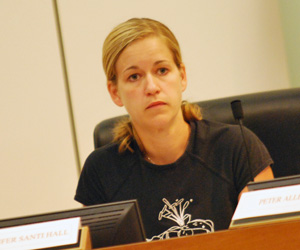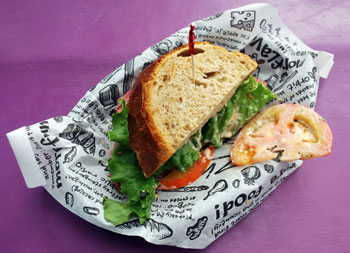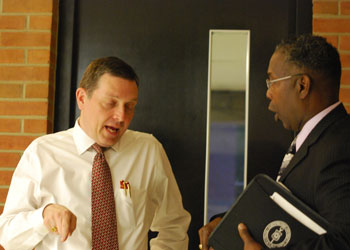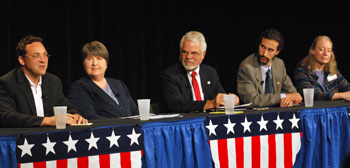Kiosk: More and more political bumper stickers popping up around town. [photo]
Archive for July, 2010
UM: Ivory Tower
The Chronicle of Higher Education reports on changes in academia over the past decade, with some saying that research universities in particular have become pressure cookers of competition. The article quores Abigail J. Stewart, a UM professor of psychology and women’s studies. “I’m always skeptical of framing the past as a golden age. I think there is a nostalgia and a sentimentality, especially from senior men about the good old days when they played cards at lunch and wandered down the hall to shoot the breeze.” She adds: “I never experienced any of that.” [Source]
A2: Butterflies
Writing on her blog Into the Woods and Elsewhere, Cathy Carroll reports on Saturday’s Washtenaw Audubon Society butterfly field trip at Matthei Botanical Gardens: “Despite the less than desirable weather for butterflies, we still managed to find twenty species. Additionally, there was a hummingbird moth and a few different kinds of dragonflies.” She posts several photos from the outing. [Source]
A Conversation with Owen Gleiberman

Owen Gleiberman, film critic for Entertainment Weekly, grew up in Ann Arbor. (Photo courtesy of Owen Gleiberman)
Today, Owen Gleiberman of Entertainment Weekly enjoys a position as one of the country’s most influential movie critics, his opinions read and respected (and sometimes reviled) by millions. Forty years ago he was a precocious middle-schooler who carried a transcript of the Chicago Seven trial in his pocket as he roamed downtown Ann Arbor, exploring the head shops and hanging with the hippies.
Soon after enrolling at the University of Michigan in 1976, Gleiberman was bit by the movie bug and began reviewing films for the Michigan Daily. He struck up a long-distance friendship with Pauline Kael of the New Yorker, who encouraged him in his writing and helped him to land his first job after graduation as a critic for the Boston Phoenix.
Though he now lives in Greenwich Village, Gleiberman makes regular return trips to Ann Arbor to visit family and friends. Over tea at Café Felix on a sleepy Sunday afternoon, he related what it was like to grow up in the countercultural milieu of Ann Arbor in the late ’60s and early ’70s, how that experience influenced his career as a film critic, and his thoughts and hopes on the future of journalism. [Full Story]
Pontiac Trail
6:55 p.m. Piano on a bike cart heading north on Pontiac Trail.
Washington & Main
Violinist outside Mongolian Barbeque plugging Bowls for Homes fundraiser for the homeless on Wednesday, July 28 from 6-10 p.m.
A2: Governor’s Race
The Detroit Free Press is one of several media outlets to report on campaign contributions for state and local races – campaign finance reports were filed Friday. Ann Arbor venture capitalist Rick Snyder led the candidates for governor, spending $6.5 million, including $5.9 million of his own money, the Free Press reports. “Much of that went for TV ads, which began Super Bowl Sunday and made him famous as ‘one tough nerd.’ Snyder had $811,822 left, though that could grow – he’d have to write another check – in the final week of the primary election campaign. In a statement, Snyder reported raising $1.4 million from about 3,200 individuals.” [Source]
Ann Arbor Forums: The More, The Mayor-ier
On Saturday, July 10, the Ann Arbor Democratic Party hosted a forum for mayoral candidates in the Democratic primary election, which will be held Aug. 3. The following Monday, the League of Women Voters hosted its own mayoral forum. This report combines coverage of those events. Online video of the LWV mayoral forum is available through Community Television Network’s video-on-demand service.

Patricia Lesko and John Hieftje at the League of Women Voters forum filmed at CTN studios on July 12. (Photos by the writer.)
This year Democratic voters will select between challenger Patricia Lesko and incumbent John Hieftje, who was first elected as mayor in 2000. In the November general election, the winner of the Democratic primary will face independent Steve Bean.
Based on campaign finance statements filed Friday, July 23, Lesko has so far collected 49 donations totaling $3,968 – not including a personal loan to her campaign of $1,525. Hieftje has collected 140 donations totaling $16,276. The mean donation to Lesko is $81, compared to Hieftje’s $116. A greater difference is revealed by the median donation: $50 for Lesko and $100 for Hieftje. Complete financial statements for Lesko and Hieftje are available on the county clerk’s section of ewashtenaw.org. Comparing those statements demonstrates it’s possible for one person to donate to both candidates.
Previous Chronicle coverage of the mayoral race includes: “Ann Arbor Dems Primary: Mayoral Race.”
The city Dems forum was moderated by Jim Leonard, who wrote the piece “Satan For Mayor?!” published in the July edition of the Ann Arbor Observer. [Full Story]
Church Street
Line outside Pizza House waiting to see rare Tally Hall acoustic set. [photo]
First & Kingsley
Office worker whose car was blocked by flooding makes run for it. Miraculously, he succeeded. [photo]
Ann Arbor-Saline & I-94
Four-car fender bender on Ann Arbor-Saline at i-94, in the middle of the bridge. Bonus backup on I-94 westbound doesn’t look related.
Liberty & Virginia
Woman walking eastbound wearing T-shirt. Front: Ann Arbor News 1835-2009. Back: No News is Bad News. Today is the one-year anniversary of the last day of publication of the Ann Arbor News.
A2: Gone One Year
A year ago today, the last edition of the Ann Arbor News was delivered. The Ann Arbor Chronicle covered it this way: [Source]
A2: Art & Police
A report on Fox 2 News makes a connection between the public art being installed at the new municipal center – a water sculpture by German artist Herbert Dreiseitl – and the fact that four firefighters are being laid off because of budget cuts. The segment includes an interview with Matt Schroeder with the Ann Arbor firefighter’s union: “We wonder where the priorities of the citizens are and the city council. Our concern as a local union is the safety of the citizens.” [Source] The most recent Chronicle coverage of the public art commission: “Art Commission Acts on Dreiseitl Proposal.”
Column: What I Learned at Summer Camp
With the weak economy, and high school coaches urging their players to attend “voluntary” workouts, enrollment for summer camps is down nationwide about 10%. But if the choice is between team workouts and summer camp, I say, summer camp wins hands-down.
Let me explain.
I didn’t want to go to summer camp.
I spent my summers growing up at our family cottage near Traverse City. The idea of going to Camp Hayo-Went-Ha – a YMCA camp on the lake – didn’t interest me. I liked playing baseball, riding bikes and going to hockey school with my best friend. I figured the kids who went to Hayo-Went-Ha either couldn’t play baseball or didn’t have many friends. [Full Story]
Second & Liberty
Jerks citywide offering art fair parking are outmarketed by sign with extra marketing oomph: “We’re Nice!”
Zina Pitcher & Catherine
Demolition of UM’s Kresge research buildings continues. It’s loud. [photo]
Leveling the Field for Small Farms
Ann Arbor Greenbelt Advisory Commission meeting (July 14, 2010): Small farms and local food production again was a focus of the greenbelt advisory commission (GAC), as they considered revisions to easement language and scoring criteria for the greenbelt program.

Jennifer Santi Hall was elected chair of the city's greenbelt advisory commission at their July meeting, replacing Laura Rubin in that role. (Photos by the writer.)
The discussion prompted one commissioner, Dan Ezekiel, to underscore that they weren’t trying to favor small farms – they were simply trying to offset the advantages that the program has previously afforded to larger farms.
A review of revisions to the greenbelt program’s scoring criteria included a robust discussion about the meaning of “local food economy.” One of the proposed revisions would award points to farms that produce local food and contribute to the local food economy.
Commissioner Tom Bloomer, a Webster Township farmer, argued that all farms in Washtenaw County contribute to the local food economy, either directly or indirectly. Jennifer Santi Hall, who had proposed the change, agreed to withdraw the item from the scoring criteria so that they could refine the language. But she noted that it was important to find some way of including criteria for local food production, to align the scoring of applications with the greenbelt program’s strategic plan, which includes a section on the local food economy.
Later in the meeting, after nearly an hour in closed session to discuss land acquisition, the commission recommended allocating nearly $3 million in five separate deals, the majority of them for the purchase of development rights of local farms. Those recommendations will be forwarded to city council for final approval. [Full Story]
A2: Libraries
In an essay posted to the Ann Arbor District Library website, director Josie Parker lays out the threat that TIF districts pose to library funding: “Many libraries in Michigan [...] will survive [...] but a good number of them will not. Those that do will still contend with eroding tax bases: sometimes the enemy appears friendly. The best example on the local level is Tax Increment Financing Authority [...]” Parker’s essay has generated several patron comments. [Source] Parker’s concern about the impact of TIF districts on library funding is reflected in previous Chronicle coverage: “DDA: Let’s Do Development.”
A2: Newspaper
Groundcover News – a print publication that focuses on poverty issues and aims to provide the homeless with a way to earn money – has published its first edition. The paper is founded by local activist Susan Beckett; Laurie Lounsbury serves as editor. The paper will be sold by homeless vendors throughout Ann Arbor for $1. [Source]
A2: Business
An Inc. magazine article reports on results of the 2010 American Customer Satisfaction Index, conducted by UM’s Ross School of Business and Ann Arbor-based ForeSee Results. The ACSI found that despite the popularity of the social networking site Facebook, it ranked in the bottom 5% of all companies surveyed, “along with much-loathed airlines and cable companies (and below even the IRS’s e-file service).” The article interviewed ForeSee CEO Larry Freed, who said the company’s research suggested Facebook’s low ranking was due to consumer concerns about privacy, frequent design changes and aggressive advertising. [Source]
Column: Comments, Complaints, Condiments
You say “tomato” … I say they’re gross.

#4 Zingerman's Sandwich – the Dinty Moore: Corned beef, lettuce, tomato, Russian dressing on rye bread.
But it is a fact of life that others have deemed tomatoes to be a tasty treat. They’re included in various standard salads, soups, sauces and sandwiches. Take a sandwich from Zingerman’s Deli, for example, the Dinty Moore (#4): Corned beef, lettuce, tomato, Russian dressing on rye bread.
I’m almost certain that a sandwich artist properly trained in the culture of Zingerman’s customer service would enthusiastically build me a tomato-less Dinty Moore.
But I do not want to be served such a sandwich.
I want that sandwich served to me the way the sandwich designer conceived it – with a tomato. I can then alter the sandwich to suit my individual taste by manually removing the tomato.
Why not just order a tomato-less sandwich and avoid the tomato traces that are inevitably left behind, no matter how aggressively the corned beef is blotted with a napkin? Because I want the option – up until the very last possible moment – of leaving the tomato on the sandwich, or restoring the tomato to its proper place atop the beef.
Those trace tomato flavors on my sandwich remind me that I still, apparently, dislike tomatoes. But maybe someday, it’ll occur to me that, Wow, that tastes terrific, I should put that tomato slice back on the sandwich!!
I’d like our readers to think of the public commentary we include in The Ann Arbor Chronicle’s meeting reports the same way I think of tomatoes. We include the public commentary, just in case you decide that you’d like to have a bite.
So let’s go back a year ago, to a tomato still preserved in The Chronicle’s archives as fresh as the day resident Jim Mogensen picked it. He was talking about video recording equipment to be installed in Ann Arbor police cars.
And yes, I’m going find a way, by the end of this column, to connect video recording equipment in police cars to Zingerman’s sandwiches. [Full Story]
W. Madison & 6th Ave.
Delivery of single stream recycling bins taking place. [photo]
State Street
Art fair from the wings and the shadows. [photo]
Huron Parkway & Plymouth Road
At lunchtime, two fawns, no Mama in sight, lying in the shade near the southwest corner of Huron Parkway and Plymouth Road. [photo]
Zingerman’s Moves on to HDC
Ann Arbor City Council meeting (July 19, 2010): On Monday night, Zingerman’s Deli partners enjoyed complete support with no dissent from the city council, or the community at large, for their plans to expand the Detroit Street location. The council approved the site plan for the 10,000-square-foot addition, as well as a brownfield application.

Stephen Rapundalo (Ward 2) and Ann Arbor chief of police Barnett Jones chat during a break in the July 19 council meeting just after passage of a new pedestrian ordinance. During deliberations on that ordinance, Jones had cited the Canadian cultural practice of pedestrians standing on the curb and simply pointing to the crosswalk, which prompts motorists to stop for them. The remark had earned a thumbs-up from Rapundalo, who is a dual U.S.-Canadian citizen.
Intended as an extra measure of support for Zingerman’s was a third resolution communicating to the city’s historic district commission (HDC) the council’s view that the project represents a substantial benefit to the community. The proposal includes demolition of one house and the integration of another house into the architecture of the proposed new construction. Because the site is located in the Old Fourth Ward, the HDC will need to give its approval, in order for the project to be built. The message sent by the council to the HDC was clear: We want this project approved.
The council also sent a clear message to its firefighter and police unions, which the city hopes will soon ratify contracts that will save the city money. At the meeting, the council approved labor agreements with two other groups – the Teamsters civilian supervisors and the Teamsters police professional assistants. That added to bargained changes with the police deputy chiefs union that were approved at the council’s previous meeting on July 6. All three agreements reflected cost savings to the city through greater contributions by union members to health and retirement benefits and no increase in wages.
The implicit message to the firefighter and police unions was given explicit form through a position statement from the council’s labor committee and read aloud by Stephen Rapundalo (Ward 2), the chair of that committee. The statement calls on those unions to follow the example of the three who have already ratified contracts.
The council also gave final approval to a new pedestrian safety ordinance, which requires motorists to stop for pedestrians who are in, or even approaching, crosswalks that lack any traffic control device. During deliberations, the council swapped in “stop” to make the ordinance stronger than the originally proposed “yield.”
In other business, the council authorized the specific allocation of over $1 million in already-budgeted funds to nonprofits providing human services, approved liquor licenses for two downtown businesses, authorized the hire of a community energy coordinator using federal funds, got an update on the future of the Library Lot, and heard public commentary on a range of issues. [Full Story]
Main & Miller
International Bridge Workers banner welcoming people to Ann Arbor. Wonder if there’s a banner on Stadium Boulevard. [photo]
Washtenaw Democrats: Districts 10, 11
On the evening of July 13, the four Democratic candidates for the District 11 seat on the Washtenaw County board of commissioners, as well as one candidate for District 10, gathered at the studios of Community Television Network for a forum hosted by the League of Women Voters of the Ann Arbor Area.

Washtenaw County commissioner candidates for Districts 10 & 11, from left: Conan Smith, LuAnne Bullington, Mike Fried, Yousef Rabhi, Alice Ralph. Smith is the incumbent for District 10. His challenger, Danielle Mack, did not attend. The other candidates are vying for the District 11 seat held by Jeff Irwin, who is running for state representative. (Photos by the writer.)
There are 11 seats on the county board, divided by geographic region – including four districts representing Ann Arbor. Commissioners are elected to two-year terms. This year, Democratic incumbents in two of Ann Arbor’s districts – Leah Gunn of District 9 and Barbara Bergman of District 8 – are unopposed in the primary, though they will face Republican challengers in November.
Incumbent Conan Smith of District 10, which covers the west and northwest portions of Ann Arbor, faces Danielle Mack in the Democratic primary. She did not attend the forum, citing a scheduling conflict. The winner of that primary will be unopposed in November.
In District 11, incumbent Jeff Irwin – who’s been on the board for a decade – isn’t seeking re-election, but is instead running for state representative in District 53. [See Chronicle coverage: "Michigan Dems Primary: House 53rd District"] Four Democrats are competing in the primary to replace Irwin: LuAnne Bullington, Mike Fried, Yousef Rabhi and Alice Ralph. The winner of the Aug. 3 primary will face Republican Joe Baublis in November. District 11 covers parts of central and eastern Ann Arbor. [See the Washtenaw County election website for a complete list of county commissioner candidates.]
Questions posed by the moderator, Nancy Schewe, had been formulated by a LWV-AAA committee, with input solicited from the community. They covered a range of topics, from funding for the county jail and police services contracts to expansion of the road commission and the candidates’ views on mass transit. Candidates were each given one minute to respond. This summary of candidate responses is presented in the order in which they spoke at the hour-long forum. [Full Story]
A2: Governor’s Race
The Detroit News reports on Rick Snyder’s efforts to reach out to “non-traditional” voters as the Ann Arbor businessman seeks the GOP nomination for governor. The strategy is being led by moderate Republican Joe Schwarz: “Schwarz, a Battle Creek physician who considered a run for governor as an independent, will lead a campaign called ‘Common Sense for Michigan’ to mobilize voters who have not traditionally voted in Republican primaries, the Snyder campaign announced Monday. Snyder, seen as the most moderate candidate in the five-man Republican primary Aug. 3, is hoping to draw independents and crossover votes along with Republicans while his opponents split the conservative vote.” [Source]
Liberty, east of Main
Geodesic dome being set up in parking lot next to Cupcake Station. Art Fairs! [photo]




